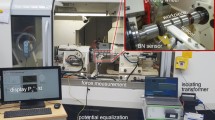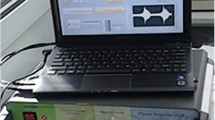Abstract
The quality of the ball screw shafts used in the aeronautical sector has to be controlled and certified with the most advanced non-destructive techniques. The capacity of magnetic Barkhausen noise (MBN) as a non-destructive technique to control the quality of ball screw shafts by assuring the appropriate induction hardened layer depth and detecting local overheated regions, known as grinding burns, which may occur during grinding processes is shown in the present work. Magnetic Barkhausen noise measurements were made with a system designed and implemented by the authors and the derived parameters were compared with microhardness measurements made at various depths after the different induction hardening treatments and the grinding processes were applied. A multiparametric study of the MBN signal as a function of the magnetic field in the surface of the sample is done in order to estimate the thickness of the hardened layer and to detect the grinding burns produced during grinding processes. The hardened layer thickness can be characterized with an error of ±200 \(\upmu \)m in the range between 150 and 2500 \(\upmu \)m by the position of the first peak of the MBN envelope in terms of the tangential magnetic field measured at the surface and the grinding burns can be detected with the position of the second peak of the MBN envelope in terms of the tangential magnetic field measured at the surface.






Similar content being viewed by others
References
Grum, J.: A review of the influence of grinding conditions on resulting residual stresses after induction surface hardening and grinding. J. Mater. Process. Technol. 114, 212–226 (2001). doi:10.1016/S0924-0136(01)00562-3
Savaria, V., Monajati, H., Bridier, F., Bocher, P.: Measurement and correction of residual stress gradients in aeronautical gears after various induction surface hardening treatments. J. Mater. Process. Technol. 220, 113–123 (2015). doi:10.1016/j.jmatprotec.2014.12.009
Bach, G., Goebbels, K., Theiner, W.A.: Characterization of hardening depth by Barkhausen noise measurement. Mater. Eval. 46, 1576–1580 (1988)
Saquet, O., Tapuleasa, D., Chicois, J.: Use of Barkhausen noise for determination of surface hardened depth. Nondestr. Test. Eval. 14, 277–292 (1998). doi:10.1080/10589759808953055
Vaidyanathan, S., Moorthy, V., Jayakumar, T., Raj, B.: Evaluation of induction hardened case depth through microstructural characterisation using magnetic Barkhausen emission technique. Mater. Sci. Technol. Ser. 16, 202–208 (2000). doi:10.1179/026708300101507550
Moorthy, V., Shaw, B.A., Day, S.: Evaluation of applied and residual stresses in case-carburised En36 steel subjected to bending using the magnetic Barkhausen emission technique. Acta Mater. 52, 1927–1936 (2004). doi:10.1016/j.actamat.2003.12.034
D’Amato, C., Verdu, C., Kleber, X., Regheere, G., Vincent, A.: Characterization of austempered ductile iron through Barkhausen noise measurements. J. Nondestr. Eval. 22, 127–139 (2003). doi:10.1023/B:JONE.0000022032.66648.c5
Kleber, X., Hug, A., Merlin, J., Soler, M.: Ferrite-martensite steels characterization using magnetic Barkhausen noise measurements. ISIJ Int. 44, 1033–1039 (2004). doi:10.2355/isijinternational.44.1033
Blaow, M., Evans, J.T., Shaw, B.A.: Effect of hardness and composition gradients on Barkhausen emission in case hardened steel. J. Magn. Magn. Mater. 303, 153–159 (2006). doi:10.1016/j.jmmm.2005.07.034
Bahadur, A., Mitra, A., Kumar, R.B., Sagar, P.S.: Evaluation and correlation of residual stress measurement in steel. J. Nondestr. Eval. 26, 47–55 (2007). doi:10.1007/s10921-007-0019-8
Davut, K., Gur, H.C.: Monitoring the microstructural changes during tempering of quenched SAE 5140 steel by magnetic Barkhausen noise. J. Nondestr. Eval. 26, 107–113 (2007). doi:10.1007/s10921-007-0025-x
Moorthy, V., Shaw, B.A.: Magnetic Barkhausen emission measurements for evaluation of material properties in gears. J. Test. Eval. 23, 317–347 (2008). doi:10.1080/10589750802275980
Gurruchaga, K., Martínez-De-Guerenu, A., Soto, M., Arizti, F.: Magnetic Barkhausen noise for characterization of recovery and recrystallization. IEEE T Magn. 46, 513–516 (2010). doi:10.1109/TMAG.2009.2029069
Santa-aho, S., Vippola, M., Sorsa, A., Latokartano, J., Lindgren, M., Leiviskä, K., et al.: Development of Barkhausen noise calibration blocks for reliable grinding burn detection. J. Mater. Process. Technol. 212, 408–416 (2012). doi:10.1016/j.jmatprotec.2011.10.003
Santa-aho, S., Vippola, M., Sorsa, A., Leiviskä, K., Lindgren, M., Lepistö, T.: Utilization of Barkhausen noise magnetizing sweeps for case-depth detection from hardened steel. NDT&E Int. 52, 95–102 (2012). doi:10.1016/j.ndteint.2012.05.005
Franco, F.A., Gonzalez, M.F.R., De Campos, M.F., Padovese, L.R.: Relation between magnetic Barkhausen noise and hardness for Jominy Quench tests in SAE 4140 and 6150 steels. J. Nondestr. Eval. 32, 93–103 (2013). doi:10.1007/s10921-012-0162-8
Vashista, M., Moorthy, V.: On the shape of the magnetic Barkhausen noise profile for better revelation of the effect of microstructures on the magnetisation process in ferritic steels. J. Magn. Magn. Mater. 393, 584–592 (2015). doi:10.1016/j.jmmm.2015.06.008
Stupakov, A., Neslusan, M., Perevertov, O.: Detection of a milling-induced surface damage by the magnetic Barkhausen noise. J. Magn. Magn. Mater. 410, 198–209 (2016). doi:10.1016/j.jmmm.2016.03.036
Jiles, D.C.: Magnetization and magnetic moment. In: Jiles, D.C. (ed.) Introduction to Magnetism and Magnetic Materials, 2nd edn, pp. 57–60. Chapman & Hall, Boca Raton (1998)
Kypris, O., Nlebedim, I.C., Jiles, D.C.: A model for the Barkhausen frequency spectrum as a function of applied stress. J. Appl. Phys. 115, 083906 (2014). doi:10.1063/1.4866195
Lasaosa, A., Gurruchaga, K., Garcia, V.N., Martinez-de-Guerenu, A.: Characterisation of in-depth stress state by magnetic Barkhausen noise on machined steel acquiring different frequency bands. Adv. Mater. Res. 996, 373–379 (2014). doi:10.4028/www.scientific.net/AMR.996.373
Haimbaugh, R.E.: Induction heat treating process analysis. In: Haimbaugh, R.E. (ed.) Practical Induction Heat Treating, 2nd edn, p. 225. ASM International, New York (2015)
ASTM E 140: Standard Hardness Conversion Tables for Metals Relationship among Brinell Hardness, Vickers Hardness, Rockwell Hardness, Superficial Hardness, Knoop Hardness, Scleroscope Hardness, and Leeb Hardness (2007)
Moorthy, V.: Unique correlation between non-linear distortion of tangential magnetic field and magnetic excitation voltage—unexplored ferromagnetic phenomena and their application for ferromagnetic materials evaluation. J. Magn. Magn. Mater. 398, 101–108 (2016). doi:10.1016/j.jmmm.2015.09.029
Acknowledgements
The authors thank KORTA S.A. for funding the development of this research.
Author information
Authors and Affiliations
Corresponding author
Rights and permissions
About this article
Cite this article
Lasaosa, A., Gurruchaga, K., Arizti, F. et al. Induction Hardened Layer Characterization and Grinding Burn Detection by Magnetic Barkhausen Noise Analysis. J Nondestruct Eval 36, 27 (2017). https://doi.org/10.1007/s10921-016-0388-y
Received:
Accepted:
Published:
DOI: https://doi.org/10.1007/s10921-016-0388-y




